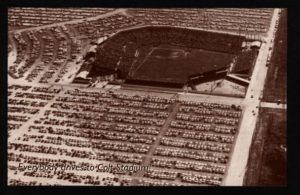
Colt Stadium in Houston. The Astrodome construction site, not pictured, is to the left. (Public domain photo)
As people consider the fate of the Houston Astrodome, one thing is certain—it won’t suffer the same ignominious fate as its predecessor.
In fairness, Colt Stadium was never envisioned as the Eighth Wonder of the World. Former Harris County Judge Roy Hofheinz had that title in mind for the Harris County Domed Stadium, which was to be built if and when Houston was granted a Major League Baseball franchise.
Major League Baseball granted Houston its franchise. The team began play in 1962. The domed stadium was built and the team began playing in it for the 1965 season.
The team, the Houston Colt .45s, needed a temporary place to play while the domed stadium was being built. So Colt Stadium was built just north of the site where the domed stadium was to be built.
Colt Stadium had no shade, awning, or roof. It had a capacity of 33,000. At the first game played there, on April 10, 1962, the Colt .45s defeated the Chicago Cubs.
Big league baseball had arrived in Southeast Texas, and fans quickly bought into Judge Hofheinz’s vision of an enclosed, air-conditioned stadium. Such a stadium might be a luxury elsewhere, but for Southeast Texas, it would be both a necessity and a luxury.
When the 1964 baseball season finished, people looked forward to playing the 1965 season indoors, as it were. But there were some other changes forthcoming.
Robert Reed, in his book, Colt .45s: A Six-Gun Salute (Lone Star Books, 1999), described what happened:
More than 50 writers in Houston for the annual winter baseball meetings filed into a hastily called press conference at the Shamrock Hilton Hotel on December 1, 1964, expecting to hear HSA (Houston Sports Association, the Astros parent company) vice chairman and president Roy Hofheinz announce a major trade.
Instead, with chairman R.E. “Bob” Smith at his side, Hofheinz abruptly informed the media gathering that the Houston Colt .45s now belonged to the ages.
“From henceforth and evermore, Houston’s baseball team will be known as the Astros,” he said.
The new name, in keeping with Houston’s emergence as the space-age capital of the world as well as the anticipated opening of the domed stadium, overturned a decision that chafed Hofheinz ever since his beginnings on the HSA campaign. Then, he had enthusiastically argued that the Bayou City’s first major league team should be called the “Stars,” only to be overruled in those early days of 1961 by other stockholders, particularly George Kirksey. Hofheinz thought Houston should claim its future and not its past, and opposed any name that traded on Texas horse and buggy days.
It was one of the few battles in which the former mayor and county judge was unable to ramrod his will over the majority.
Houston had a new stadium, which we know today as the Astrodome, and its team had a new identity. But Colt Stadium remained.
Other baseball stadiums have been demolished, but you can still stand at the sites where the stadiums stood, even run the basepaths, which were marked to commemorate the stadium sites. Chicago’s Comiskey Park, New York’s Shea Stadium, and Philadelphia’s Veterans Stadium, are examples of this.
The Colt Stadium site, by contrast, suffered what might be considered a typical Houston fate. It was left in disrepair when the team moved into the Astrodome. It was eventually disassembled, removed, forgotten, and built over by something else. Today NRG Center stands on the old stadium site. No historical markers commemorate the site.
The disassembled stadium was rebuilt in Mexico.
Perhaps Colt Stadium deserves a better fate in Houston history. But one has to begin somewhere.
The Astros begin their 2017 season Monday night at Minute Maid Park, in which they’ve played since 2000.
